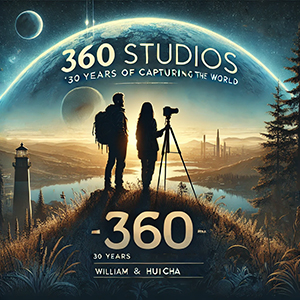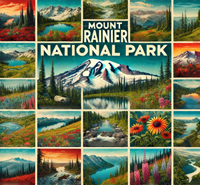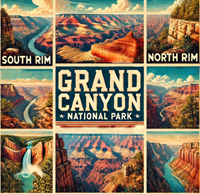

Embark on a journey curated by seasoned explorers William and Hui Cha Stanek, who have spent decades immersing themselves in the diverse landscapes of North America. These itineraries are more than just travel plans - they are thoughtfully crafted adventures designed to help you connect with the natural world, discover hidden gems, and create lasting memories.
National Parks Index | US Itineraries Index | American Roadtrips Index

Bring home a Bugville Critters book and watch as your child's love for reading and learning grows with every page. Hand-painted illustrations bring the heartwarming stories to life. Ask your librarian to add Bugville Critters to the library's digital collection today!
Discover William Stanek's Exclusive Art Collection
Explore and purchase the stunning art featured on this site. Own a piece of William Stanek's unique and captivating artwork today!
(May 3, 2025) Ultimate 5-Day Adventure Through Biscayne, Dry Tortugas, and Everglades National Parks
Introduction: Exploring Florida's Wild and Watery Wilderness
Florida's national parks offer a unique adventure unlike any other, where lush wetlands, crystal-clear waters, and ancient coral reefs create a vibrant ecosystem teeming with life. Our five-day journey through Biscayne, Dry Tortugas, and Everglades National Parks took us deep into the heart of this wild and watery wilderness, where we encountered pristine beaches, colorful coral reefs, and the largest subtropical wilderness in the United States.
Each park has its own distinct character: Biscayne with its clear waters and underwater treasures; Dry Tortugas, a remote island paradise with a rich history; and Everglades, a vast and mysterious ecosystem home to an incredible diversity of wildlife. This trip is perfect for those seeking adventure and relaxation, combining scenic boat rides, snorkeling, hiking, and wildlife encounters. Our itinerary is designed to help you make the most of your time in these incredible parks, with detailed guidance, photography tips, and alternatives for those who prefer a more relaxed pace.
Join us as we embark on this unforgettable journey through the stunning and unique landscapes of Florida's national parks.
Day 1: Biscayne National Park – The Underwater Paradise
Morning: Snorkeling at the Coral Reefs
Overview
Start your adventure with a morning snorkeling trip to the coral reefs of Biscayne National Park, home to one of the largest and most diverse coral reef systems in the world. This underwater paradise is teeming with marine life, including colorful fish, sea turtles, and vibrant coral formations.
Tips from William
"To make the most of your snorkeling experience, arrive early to catch the best light and the calmest waters. Bring a waterproof camera or a GoPro to capture the vibrant colors and intricate details of the coral reefs. Don't forget to bring an underwater flashlight for better visibility when exploring deeper sections."
Insights from Hui Cha
"Snorkeling in Biscayne is like entering another world. The clarity of the water, the vibrant colors of the coral, and the abundance of marine life make it an unforgettable experience. Take your time to float and observe the fish and other creatures in their natural habitat. It's a peaceful and mesmerizing way to start your day."
How to Access the Coral Reefs
Directions:
- From Miami, head south to Homestead and enter Biscayne National Park at the Dante Fascell Visitor Center. From there, join a guided snorkeling tour or rent a boat to access the coral reefs, which are located about 10 miles offshore.
Snorkeling Details:
- Location: Offshore from the Dante Fascell Visitor Center
- Difficulty: Easy to Moderate (depending on water conditions)
Photography Tips: For the best underwater shots, ensure you have a waterproof camera with a wide-angle lens to capture the full scope of the reefs. Use natural light as much as possible, and be patient with the marine life – some of the best moments come when you're least expecting them.
Alternative Activity: If snorkeling isn't for you, consider taking a glass-bottom boat tour. You'll still get to experience the beauty of the coral reefs without getting wet, and the tour guides provide informative insights about the ecosystem.
Mid-Morning: Exploring the Mangrove Coastline by Kayak
Overview
After your snorkeling adventure, spend the mid-morning kayaking through the mangrove-lined coast of Biscayne. This is a peaceful way to explore the park's shallow waters, where you can observe the unique mangrove ecosystem up close.
Tips from William
"Kayaking through the mangroves is all about taking it slow and quiet. The calmer you are, the more wildlife you'll encounter. Bring a waterproof bag for your camera and binoculars to spot birds and other wildlife. Early mornings are best for seeing manatees and other shy creatures."
Insights from Hui Cha
"Gliding through the mangroves feels like you're entering a secret world. The stillness of the water, the rustling of the leaves, and the occasional splash of a fish or the sight of a bird taking flight make it a serene and almost meditative experience. It's a great way to connect with nature."
How to Access the Mangrove Coastline
Directions:
- Launch your kayak from the Dante Fascell Visitor Center or from various other points along the park's coastline. There are several marked kayak trails that guide you through the mangroves.
Kayak Details:
- Location: Accessible from various points along the coast
- Difficulty: Easy
Photography Tips: Bring a waterproof camera or a smartphone with a waterproof case to capture the scenery. Focus on the reflections in the water and the light filtering through the mangrove leaves. A zoom lens will be useful for capturing birds and other wildlife from a distance.
Alternative Activity: If kayaking sounds too strenuous, consider taking a ranger-led boat tour of the mangroves. This provides a more relaxed experience with plenty of opportunities for photography and learning about the ecosystem.
Afternoon: Visit to Boca Chita Key
Overview
In the afternoon, take a boat ride to Boca Chita Key, one of the most popular islands in Biscayne National Park. Here, you can explore the historic lighthouse, enjoy a picnic by the beach, and take in the stunning views of the Miami skyline from afar.
Tips from William
"Boca Chita Key is a great spot for a relaxed afternoon. Bring a wide-angle lens to capture the iconic lighthouse and the surrounding landscape. The beach is also a great place for sunset photography, with the Miami skyline in the background."
Insights from Hui Cha
"Visiting Boca Chita Key is like stepping back in time. The historic lighthouse and the quiet beach offer a glimpse into Florida's past, while the views of the water and the city skyline remind you of the connection between nature and urban life. It's a perfect place to unwind and enjoy the beauty of Biscayne."
How to Access Boca Chita Key
Directions:
- From the Dante Fascell Visitor Center, take a guided boat tour or rent a boat to reach Boca Chita Key, located about 7 miles offshore.
Island Details:
- Location: 7 miles from the mainland
- Difficulty: Easy
Photography Tips: For the best shots of Boca Chita Key, arrive in the late afternoon to capture the lighthouse and the beach in the golden hour light. Use a tripod for stability, and experiment with different angles to include the Miami skyline in the background.
Alternative Activity: If you prefer a less crowded spot, consider visiting Elliott Key, the largest island in Biscayne National Park. It offers more seclusion and excellent opportunities for hiking and swimming.
Evening: Sunset at the Dante Fascell Visitor Center
Overview
End your first day in Biscayne with a sunset at the Dante Fascell Visitor Center. The center's location on the edge of Biscayne Bay provides a perfect vantage point to watch the sun dip below the horizon, painting the sky with brilliant hues of orange and pink.
Tips from William
"Sunsets in Biscayne are spectacular, especially with the calm waters of the bay reflecting the colors of the sky. Set up your tripod well before sunset to find the best angle, and use a wide-angle lens to capture the full scene. A graduated neutral density filter will help balance the exposure between the bright sky and the darker water."
Insights from Hui Cha
"Watching the sunset over Biscayne Bay is a serene and calming experience. The water reflects the colors of the sky, creating a beautiful mirror effect that's perfect for photography. Bring a blanket and a warm drink, and take some time to simply sit and enjoy the moment."
How to Access the Dante Fascell Visitor Center
Directions:
- The Dante Fascell Visitor Center is located in Homestead, just a short drive from Miami.
Viewpoint Details:
- Location: Homestead, FL
- Elevation Gain: None
- Difficulty: Easy
Photography Tips: For a stunning sunset shot, position yourself on the shoreline to capture the reflection of the sky in the water. Use a small aperture (f/16 or smaller) to keep the entire scene in focus, and experiment with different shutter speeds to capture the changing light.
Alternative Activity: If you prefer a more remote location for sunset, consider heading back to Boca Chita Key or Elliott Key, where you can watch the sunset in solitude, away from the crowds.
Day 2: Dry Tortugas National Park – A Remote Island Adventure
Morning: Fort Jefferson and Snorkeling at Garden Key
Overview
Begin your second day with an early morning ferry ride or seaplane trip to Dry Tortugas National Park, one of the most remote and pristine national parks in the United States. Your first stop is Garden Key, home to the historic Fort Jefferson, where you can explore the massive 19th-century fort and snorkel in the crystal-clear waters surrounding the island.
Tips from William
"Fort Jefferson is a photographer's dream, with its massive brick walls, picturesque arches, and stunning ocean views. Bring a wide-angle lens to capture the full scale of the fort, and a polarizing filter to reduce glare from the water. The best light for photography is in the morning when the sun is still low in the sky."
Insights from Hui Cha
"Exploring Fort Jefferson is like stepping back in time. The fort's history, combined with the natural beauty of the surrounding waters, makes it a fascinating and beautiful place to visit. After touring the fort, cool off with a snorkel in the clear waters around the island. The coral reefs here are home to a vibrant array of marine life, making it one of the best snorkeling spots in Florida."
How to Access Garden Key
Directions:
- Take the ferry from Key West or book a seaplane flight to Dry Tortugas National Park. The ferry ride takes about 2 hours and departs early in the morning.
Island Details:
- Location: 70 miles west of Key West
- Difficulty: Easy to Moderate (depending on the activity)
Photography Tips: For the best shots of Fort Jefferson, arrive early to catch the soft morning light. Use a wide-angle lens to capture the entire fort in one frame, and experiment with different compositions to highlight the fort's unique architecture against the backdrop of the ocean.
Alternative Activity: If you prefer a less strenuous activity, consider taking a guided tour of the fort instead of snorkeling. The tour provides fascinating insights into the history of Fort Jefferson and the surrounding area.
Mid-Morning: Snorkeling at the Moat Wall
Overview
After exploring Fort Jefferson, continue your snorkeling adventure along the moat wall that encircles the fort. This is one of the best places in Dry Tortugas to see colorful coral, sponges, and a variety of tropical fish up close.
Tips from William
"The moat wall is a unique snorkeling spot, with plenty of marine life to see just below the surface. Bring an underwater camera to capture the vibrant colors and intricate details of the coral and fish. If you're lucky, you might even spot a sea turtle or two."
Insights from Hui Cha
"Snorkeling along the moat wall is like swimming in an aquarium. The water is crystal clear, and the abundance of marine life makes it an unforgettable experience. Take your time and enjoy the underwater world – you never know what you might find."
How to Access the Moat Wall
Directions:
- The moat wall is located just off the shore of Garden Key, near Fort Jefferson. You can access it directly from the beach.
Snorkeling Details:
- Location: Garden Key
- Difficulty: Easy
Photography Tips: For the best underwater shots, ensure you have a waterproof camera or a GoPro. Focus on capturing the details of the coral and the vibrant colors of the fish. Use natural light as much as possible, and be patient – some of the best shots come when you least expect them.
Alternative Activity: If snorkeling isn't for you, consider a leisurely walk around the fort's moat. The views from the moat wall are stunning, and you can still enjoy the beauty of the surrounding waters without getting wet.
Afternoon: Birdwatching at Bush Key
Overview
In the afternoon, take a short boat ride or kayak trip to Bush Key, a nearby island that's a haven for birdwatchers. During the nesting season, this small island is home to thousands of nesting seabirds, including sooty terns, brown noddies, and frigatebirds.
Tips from William
"Bush Key is a paradise for birdwatchers and photographers. Bring a telephoto lens to capture the details of the birds, especially if you're shooting from a distance. Early afternoon is a great time to visit, as the birds are often more active and easier to spot."
Insights from Hui Cha
"Birdwatching at Bush Key is a peaceful and fascinating experience. The sheer number of birds nesting on the island is incredible, and the sight of them soaring above the ocean is truly awe-inspiring. It's a great place to sit quietly and observe nature at its finest."
How to Access Bush Key
Directions:
- From Garden Key, take a short boat ride or kayak trip to Bush Key. The island is located just a short distance away and is easily accessible.
Island Details:
- Location: Adjacent to Garden Key
- Difficulty: Easy
Photography Tips: For the best bird photography, use a telephoto lens to capture the details of the birds without disturbing them. Focus on the action – birds taking off, landing, or feeding their chicks make for great shots. A tripod or monopod can help stabilize your camera for sharp images.
Alternative Activity: If birdwatching isn't your thing, consider snorkeling or swimming in the clear waters around Garden Key. The shallow waters near the island are perfect for a relaxing afternoon in the sun.
Evening: Sunset at Loggerhead Key
Overview
End your day with a visit to Loggerhead Key, the largest island in Dry Tortugas National Park and home to a historic lighthouse. The island's remote location and pristine beaches make it a perfect spot to watch the sunset.
Tips from William
"Loggerhead Key is a beautiful and secluded spot for sunset photography. Bring a wide-angle lens to capture the full scene, including the lighthouse, the beach, and the ocean. The golden hour light is perfect for creating warm, glowing images."
Insights from Hui Cha
"Watching the sunset at Loggerhead Key is a peaceful and unforgettable experience. The sound of the waves, the warm breeze, and the sight of the sun sinking below the horizon create a sense of calm and connection to nature. It's a perfect way to end the day."
How to Access Loggerhead Key
Directions:
- From Garden Key, take a short boat ride or kayak trip to Loggerhead Key. The island is located about 3 miles west of Garden Key and is easily accessible by water.
Island Details:
- Location: 3 miles from Garden Key
- Difficulty: Easy
Photography Tips: For a stunning sunset shot, position yourself on the beach to capture the lighthouse and the ocean in the golden hour light. Use a small aperture (f/16 or smaller) to keep the entire scene in focus, and experiment with different shutter speeds to capture the changing light.
Alternative Activity: If you prefer a more relaxed evening, consider staying on Garden Key and watching the sunset from the beach near Fort Jefferson. The views are equally stunning, and you can enjoy the sunset with fewer logistical concerns.
Day 3: Everglades National Park – The River of Grass
Morning: Sunrise at Shark Valley
Overview
Start your third day with a sunrise visit to Shark Valley, one of the most accessible and wildlife-rich areas of Everglades National Park. The 15-mile loop trail here offers incredible opportunities to see alligators, wading birds, and other wildlife in their natural habitat.
Tips from William
"Shark Valley is a fantastic place for wildlife photography, especially in the early morning when the animals are most active. Bring a telephoto lens to capture close-up shots of alligators and birds. The best light for photography is at sunrise, when the sun is low in the sky and the light is soft and golden."
Insights from Hui Cha
"Exploring Shark Valley at sunrise is a magical experience. The stillness of the morning, the sight of the mist rising from the water, and the sounds of the birds waking up create a sense of peace and connection to nature. It's a great way to start your day in the Everglades."
How to Access Shark Valley
Directions:
- From Miami, take US-41 (Tamiami Trail) west to the Shark Valley Visitor Center. The loop trail begins at the visitor center.
Trail Details:
- Location: 45 miles west of Miami
- Trail Length: 15-mile loop (bike or walk)
- Difficulty: Easy
Photography Tips: For the best wildlife shots, use a telephoto lens to capture the details of the animals without disturbing them. Focus on the action – alligators basking in the sun, birds fishing, and other wildlife behaviors make for great photos.
Alternative Activity: If biking or walking the 15-mile loop sounds too strenuous, consider taking a guided tram tour. The tour covers the entire loop and provides excellent opportunities for wildlife viewing and photography.
Mid-Morning: Airboat Ride in the Everglades
Overview
After exploring Shark Valley, take an exhilarating airboat ride through the Everglades. This is one of the best ways to experience the vastness of the Everglades and to see its wildlife up close, including alligators, manatees, and a variety of birds.
Tips from William
"Airboat rides are thrilling and offer unique photo opportunities. Bring a waterproof camera or a camera with a good strap to keep it secure during the ride. A wide-angle lens is ideal for capturing the vastness of the Everglades, while a telephoto lens will help you get close-up shots of wildlife."
Insights from Hui Cha
"Riding an airboat through the Everglades is an adventure you won't forget. The speed, the wind in your hair, and the thrill of seeing alligators and other wildlife up close make it an exciting way to experience this unique ecosystem. It's both fun and educational."
How to Access an Airboat Ride
Directions:
- Airboat rides are available at several locations along US-41 (Tamiami Trail) and within Everglades City. Book your tour in advance to ensure availability.
Airboat Ride Details:
- Location: Various locations within Everglades National Park
- Difficulty: Easy
Photography Tips: For the best shots during your airboat ride, keep your camera ready at all times. Wildlife can appear suddenly, and you'll need to act quickly to capture the moment. Use a fast shutter speed to prevent motion blur, and experiment with different angles to capture the movement of the water and the boat.
Alternative Activity: If you prefer a quieter, more relaxed experience, consider taking a guided kayak tour through the mangroves. This allows for a closer, more intimate encounter with the wildlife and the unique landscape of the Everglades.
Afternoon: Hiking the Anhinga Trail
Overview
In the afternoon, take a hike along the Anhinga Trail, one of the most popular and accessible trails in Everglades National Park. This short trail offers excellent opportunities to see alligators, turtles, and a variety of birds up close.
Tips from William
"The Anhinga Trail is perfect for close-up wildlife photography. Bring a telephoto lens to capture the details of the animals, especially the birds and alligators. Early afternoon is a good time to visit, as the light is still soft and the animals are often more active."
Insights from Hui Cha
"Hiking the Anhinga Trail is like walking through a wildlife sanctuary. The abundance of birds, the sight of alligators sunning themselves, and the beauty of the wetlands make it a fascinating and enjoyable experience. It's a great place to observe and photograph the unique wildlife of the Everglades."
How to Access the Anhinga Trail
Directions:
- The Anhinga Trail is located near the Royal Palm Visitor Center, just a short drive from the main entrance to Everglades National Park.
Trail Details:
- Location: Royal Palm Visitor Center
- Trail Length: 0.8 miles round-trip
- Difficulty: Easy
Photography Tips: For the best shots of wildlife along the Anhinga Trail, use a telephoto lens to capture the details of the animals without disturbing them. Focus on the action – birds fishing, alligators swimming, and other wildlife behaviors make for great photos. A tripod or monopod can help stabilize your camera for sharp images.
Alternative Activity: If the Anhinga Trail is too crowded, consider exploring the nearby Gumbo Limbo Trail, a short walk through a lush, tropical hardwood hammock that offers a different perspective on the Everglades ecosystem.
Evening: Sunset at Flamingo Visitor Center
Overview
End your day with a visit to the Flamingo Visitor Center, located at the southern tip of Everglades National Park. This area offers stunning views of Florida Bay and is a great place to watch the sunset.
Tips from William
"Sunsets at Flamingo are spectacular, especially with the bay and the mangroves in the foreground. Set up your tripod well before sunset to find the best angle, and use a wide-angle lens to capture the full scene. A graduated neutral density filter will help balance the exposure between the bright sky and the darker landscape."
Insights from Hui Cha
"Watching the sunset at Flamingo is a peaceful and beautiful experience. The colors of the sky, the reflection in the water, and the sound of the waves create a serene atmosphere that's perfect for ending the day. Bring a blanket and a warm drink, and take some time to simply sit and enjoy the moment."
How to Access the Flamingo Visitor Center
Directions:
- From the Royal Palm Visitor Center, take the main park road south to the Flamingo Visitor Center. The drive takes about an hour and passes through some of the most scenic areas of the park.
Viewpoint Details:
- Location: Flamingo Visitor Center
- Elevation Gain: None
- Difficulty: Easy
Photography Tips: For a stunning sunset shot, position yourself on the shoreline to capture the reflection of the sky in the water. Use a small aperture (f/16 or smaller) to keep the entire scene in focus, and experiment with different shutter speeds to capture the changing light.
Alternative Activity: If you prefer a more remote location for sunset, consider heading to Eco Pond, a short distance from the visitor center. The pond is a popular spot for birdwatching and offers beautiful views of the sunset with fewer crowds.
Day 4: Biscayne National Park – A Return to the Water
Morning: Diving at the Maritime Heritage Trail
Overview
Begin your fourth day with a dive along the Maritime Heritage Trail, an underwater trail that showcases the shipwrecks and other cultural artifacts of Biscayne National Park. This is one of the best places in the park to see the remnants of historic ships and the marine life that now calls them home.
Tips from William
"Diving along the Maritime Heritage Trail is a unique experience, offering both historical and natural beauty. Bring an underwater camera to capture the details of the shipwrecks and the marine life. The best light for underwater photography is in the morning when the water is calm and clear."
Insights from Hui Cha
"Exploring the shipwrecks along the Maritime Heritage Trail is like diving into history. The sight of these old ships, now teeming with marine life, is both eerie and beautiful. It's a fascinating way to connect with the past while enjoying the natural beauty of Biscayne."
How to Access the Maritime Heritage Trail
Directions:
- The Maritime Heritage Trail is located offshore from the Dante Fascell Visitor Center. You'll need to join a guided dive tour or rent a boat to access the trail.
Diving Details:
- Location: Offshore from the Dante Fascell Visitor Center
- Difficulty: Moderate (requires diving certification)
Photography Tips: For the best underwater shots, use a wide-angle lens to capture the full scope of the shipwrecks. Focus on the details – coral growing on the hull, schools of fish swimming through the remains, and the play of light on the underwater structures.
Alternative Activity: If diving isn't for you, consider snorkeling or taking a glass-bottom boat tour to see the shipwrecks from above. You'll still get a sense of the history and beauty of the area without the need for diving gear.
Mid-Morning: Exploring Jones Lagoon by Canoe
Overview
After your dive, head to Jones Lagoon, a secluded and pristine area of Biscayne National Park known for its crystal-clear waters and abundant marine life. Canoeing through the lagoon is a peaceful and immersive way to experience this unique ecosystem.
Tips from William
"Jones Lagoon is a beautiful and tranquil spot for photography. Bring a waterproof camera or a camera with a waterproof case to capture the scenery and wildlife. The calm waters of the lagoon are perfect for reflection shots, especially in the mid-morning light."
Insights from Hui Cha
"Canoeing through Jones Lagoon feels like you've entered a hidden paradise. The clear waters, the sight of fish swimming below, and the mangroves surrounding the lagoon create a peaceful and almost otherworldly atmosphere. It's a wonderful way to connect with nature."
How to Access Jones Lagoon
Directions:
- From the Dante Fascell Visitor Center, take a guided canoe tour or rent a canoe to explore Jones Lagoon. The lagoon is located on the eastern side of Biscayne Bay.
Canoeing Details:
- Location: Jones Lagoon, Biscayne Bay
- Difficulty: Easy
Photography Tips: For the best shots of Jones Lagoon, focus on capturing the reflections in the water and the play of light through the mangroves. A polarizing filter can help reduce glare and enhance the colors of the water and vegetation.
Alternative Activity: If canoeing isn't your thing, consider taking a paddleboard tour of the lagoon. It's a great way to experience the area while standing, giving you a higher vantage point for photography and wildlife spotting.
Afternoon: Relaxing on the Beach at Elliott Key
Overview
In the afternoon, head to Elliott Key, the largest island in Biscayne National Park. The island's pristine beaches, clear waters, and peaceful atmosphere make it a perfect spot to relax, swim, and enjoy the beauty of the park.
Tips from William
"Elliott Key is a great spot for beach and landscape photography. Bring a wide-angle lens to capture the expansive views of the beach and ocean, and a polarizing filter to enhance the colors of the water and sky. The soft afternoon light is perfect for creating warm, glowing images."
Insights from Hui Cha
"Spending time on the beach at Elliott Key is a peaceful and rejuvenating experience. The sound of the waves, the feel of the sand between your toes, and the sight of the ocean stretching out before you create a sense of calm and relaxation. It's a perfect way to unwind and enjoy the beauty of Biscayne."
How to Access Elliott Key
Directions:
- From the Dante Fascell Visitor Center, take a boat or ferry to Elliott Key, located about 8 miles offshore.
Beach Details:
- Location: Elliott Key
- Difficulty: Easy
Photography Tips: For the best beach shots, arrive in the early afternoon to capture the soft light on the sand and water. Use a wide-angle lens to include as much of the scene as possible, and experiment with different angles to create a sense of depth and scale.
Alternative Activity: If you prefer a more active afternoon, consider hiking the Elliott Key Loop Trail, a 7-mile loop that takes you through the island's interior, offering beautiful views of the mangroves and hardwood hammocks.
Evening: Stargazing at Biscayne Bay
Overview
End your day with a stargazing session on the shores of Biscayne Bay. With little light pollution, the park offers some of the best stargazing opportunities in southern Florida. The sight of the Milky Way stretching across the sky is a perfect way to end your day.
Tips from William
"Biscayne's clear skies and remote location make it a great spot for stargazing. Bring a tripod and a wide-angle lens to capture the full expanse of the night sky. Use a low ISO setting to reduce noise, and experiment with long exposures to capture the stars and the Milky Way."
Insights from Hui Cha
"Stargazing at Biscayne Bay is a peaceful and awe-inspiring experience. The sight of the stars reflected in the calm waters of the bay, the sound of the waves gently lapping against the shore, and the stillness of the night create a sense of wonder and connection to the universe. It's a perfect way to end the day."
How to Access Biscayne Bay for Stargazing
Directions:
- The best stargazing spots are along the shorelines of Biscayne Bay. The areas around the Dante Fascell Visitor Center and Elliott Key are particularly good for stargazing.
Stargazing Details:
- Location: Biscayne Bay
- Elevation Gain: None
- Difficulty: Easy
Photography Tips: For the best stargazing shots, use a tripod to keep your camera steady during long exposures. A wide-angle lens will allow you to capture the full expanse of the night sky, and a remote shutter release can help reduce camera shake.
Alternative Activity: If stargazing isn't for you, consider a nighttime boat tour of Biscayne Bay. The views of the stars from the water are incredible, and you might even see bioluminescent plankton lighting up the waves.
Day 5: Everglades National Park – A Return to the Wilderness
Morning: Birdwatching at Eco Pond
Overview
Start your final day with a morning birdwatching session at Eco Pond, one of the best places in Everglades National Park to see a variety of wading birds, including herons, egrets, and roseate spoonbills. The pond is also home to alligators and other wildlife, making it a great spot for photography.
Tips from William
"Eco Pond is a fantastic spot for bird photography. Bring a telephoto lens to capture the details of the birds and their behaviors. The best light for photography is in the early morning when the sun is low in the sky and the light is soft and golden."
Insights from Hui Cha
"Birdwatching at Eco Pond is a peaceful and fascinating experience. The sight of the birds wading through the water, the sounds of their calls, and the stillness of the pond create a sense of connection to nature. It's a great way to start your day in the Everglades."
How to Access Eco Pond
Directions:
- Eco Pond is located near the Flamingo Visitor Center, at the southern end of Everglades National Park.
Viewpoint Details:
- Location: Flamingo, FL
- Elevation Gain: None
- Difficulty: Easy
Photography Tips: For the best bird photography, use a telephoto lens to capture close-up shots of the birds without disturbing them. Focus on the action – birds feeding, flying, or interacting with each other make for great photos. A tripod or monopod can help stabilize your camera for sharp images.
Alternative Activity: If birdwatching isn't your thing, consider taking a morning canoe trip on Nine Mile Pond, located nearby. The calm waters and abundant wildlife make it a great spot for a peaceful paddle and photography.
Mid-Morning: Hiking the Mahogany Hammock Trail
Overview
After birdwatching at Eco Pond, take a hike along the Mahogany Hammock Trail, a short boardwalk trail that winds through one of the largest remaining mahogany forests in the United States. This trail offers a different perspective on the Everglades, with its lush, tropical vegetation and towering trees.
Tips from William
"The Mahogany Hammock Trail is perfect for landscape and macro photography. Bring a wide-angle lens to capture the full scale of the forest, and a macro lens for close-up shots of the plants and insects. The soft light filtering through the trees creates a beautiful, almost magical atmosphere."
Insights from Hui Cha
"Hiking the Mahogany Hammock Trail is like stepping into another world. The cool, shaded forest, the sounds of birds and insects, and the sight of the massive mahogany trees create a sense of wonder and connection to nature. It's a peaceful and refreshing way to experience the Everglades."
How to Access the Mahogany Hammock Trail
Directions:
- The Mahogany Hammock Trail is located off the main park road, about halfway between the Flamingo Visitor Center and the main entrance to Everglades National Park.
Trail Details:
- Location: Off the main park road
- Trail Length: 0.5 miles round-trip
- Difficulty: Easy
Photography Tips: For the best shots of the forest along the Mahogany Hammock Trail, focus on capturing the light filtering through the trees and the details of the vegetation. A wide-angle lens will allow you to include as much of the scene as possible, and a macro lens is great for capturing the small details of the plants and insects.
Alternative Activity: If you prefer a longer hike, consider exploring the nearby Snake Bight Trail, a 3.2-mile round-trip trail that leads to a beautiful mangrove-lined bay, offering excellent birdwatching and photography opportunities.
Afternoon: Exploring the Flamingo Backcountry
Overview
In the afternoon, head into the backcountry around Flamingo, where you can explore the remote and wild areas of the Everglades by canoe or kayak. This is a great way to see the park's diverse habitats, from mangrove forests to sawgrass prairies, and to encounter wildlife in their natural environment.
Tips from William
"Exploring the Flamingo backcountry by canoe or kayak offers unique photo opportunities. Bring a waterproof camera or a camera with a waterproof case to capture the scenery and wildlife. The quiet waters and remote locations are perfect for peaceful, reflective shots."
Insights from Hui Cha
"Heading into the backcountry is an adventure like no other. The stillness of the water, the vastness of the landscape, and the sense of being far from civilization create a feeling of awe and connection to nature. It's a beautiful and inspiring way to experience the Everglades."
How to Access the Flamingo Backcountry
Directions:
- Canoes and kayaks can be rented from the Flamingo Visitor Center. There are several marked trails that guide you through the backcountry, including the Hell's Bay Canoe Trail and the Nine Mile Pond Canoe Trail.
Canoeing/Kayaking Details:
- Location: Flamingo, FL
- Difficulty: Easy to Moderate (depending on the trail)
Photography Tips: For the best shots in the backcountry, focus on capturing the reflections in the water and the play of light through the mangroves. A polarizing filter can help reduce glare and enhance the colors of the water and vegetation.
Alternative Activity: If canoeing or kayaking isn't your thing, consider taking a guided boat tour of the backcountry. The tours offer excellent opportunities for wildlife viewing and photography, with the added benefit of a knowledgeable guide to point out the park's natural features.
Evening: Sunset at Long Pine Key
Overview
End your five-day adventure with a sunset at Long Pine Key, a peaceful and beautiful spot located near the main entrance to Everglades National Park. The area's pine rocklands and open vistas provide a perfect setting for watching the sunset and reflecting on your journey through Florida's national parks.
Tips from William
"Long Pine Key is a fantastic spot for sunset photography, with wide, open views of the sky and the surrounding landscape. Set up your tripod well before sunset to find the best angle, and use a wide-angle lens to capture the full scene. A graduated neutral density filter will help balance the exposure between the bright sky and the darker landscape."
Insights from Hui Cha
"Sunset at Long Pine Key is a peaceful and beautiful way to end the day. The colors of the sky, the sound of the wind in the pines, and the stillness of the evening create a sense of calm and connection to nature. It's a perfect way to reflect on the journey and the beauty of the Everglades."
How to Access Long Pine Key
Directions:
- Long Pine Key is located near the main entrance to Everglades National Park, just a short drive from the Ernest F. Coe Visitor Center.
Viewpoint Details:
- Location: Near the main entrance
- Elevation Gain: None
- Difficulty: Easy
Photography Tips: For a stunning sunset shot, position yourself on the western side of the lake to capture the last light of the day as it illuminates the sky and the surrounding landscape. Use a small aperture (f/16 or smaller) to keep the entire scene in focus, and experiment with different shutter speeds to capture the changing light.
Alternative Activity: If you prefer a more remote location for sunset, consider heading back to Flamingo and watching the sunset from the shore of Florida Bay. The views of the sunset reflecting on the water, with the silhouettes of the mangroves in the foreground, are stunning and offer a perfect way to end your adventure.
Conclusion: A Personal Reflection
As the last rays of sunlight faded from the sky and the stars began to emerge, Hui Cha and I stood quietly at Long Pine Key, reflecting on the incredible journey we had just completed. From the underwater wonders of Biscayne to the remote beauty of Dry Tortugas and the vast wilderness of the Everglades, each moment had been a reminder of the sheer power and beauty of Florida's national parks.
These parks are more than just places to visit – they are places to connect with the natural world, to find peace and inspiration, and to create memories that will last a lifetime. As we packed up our gear and prepared to leave the Everglades, I felt a deep sense of gratitude for the time we had spent in these wild, untamed places. They had not only shown us the beauty of the land but had also brought us closer to each other and to the world around us.
Our journey through Biscayne, Dry Tortugas, and Everglades had come to an end, but the experiences we had shared would stay with us forever. And as we drove away from the wilderness, I knew that we would return, drawn back by the promise of new adventures and the chance to explore even deeper into the heart of Florida's natural wonders.

Step into a world of timeless beauty with our premium, oversized hardcover book - crafted for discerning collectors and anyone who values the power of art. Perfect for your coffee table, it's more than just a book; it's a conversation starter, a window into over 30 years of William's visionary photography.
Your Support Matters
Purchasing artwork from William Stanek's collection not only brings beauty into your life but also helps us continue to share. Thank you for supporting our creative journey!

Support The Lights of Paris by Robert Stanek, William Stanek's pen name! Through vivid historical detail and deeply moving character stories, Robert takes readers on an unforgettable journey through one of history’s most transformative times.












